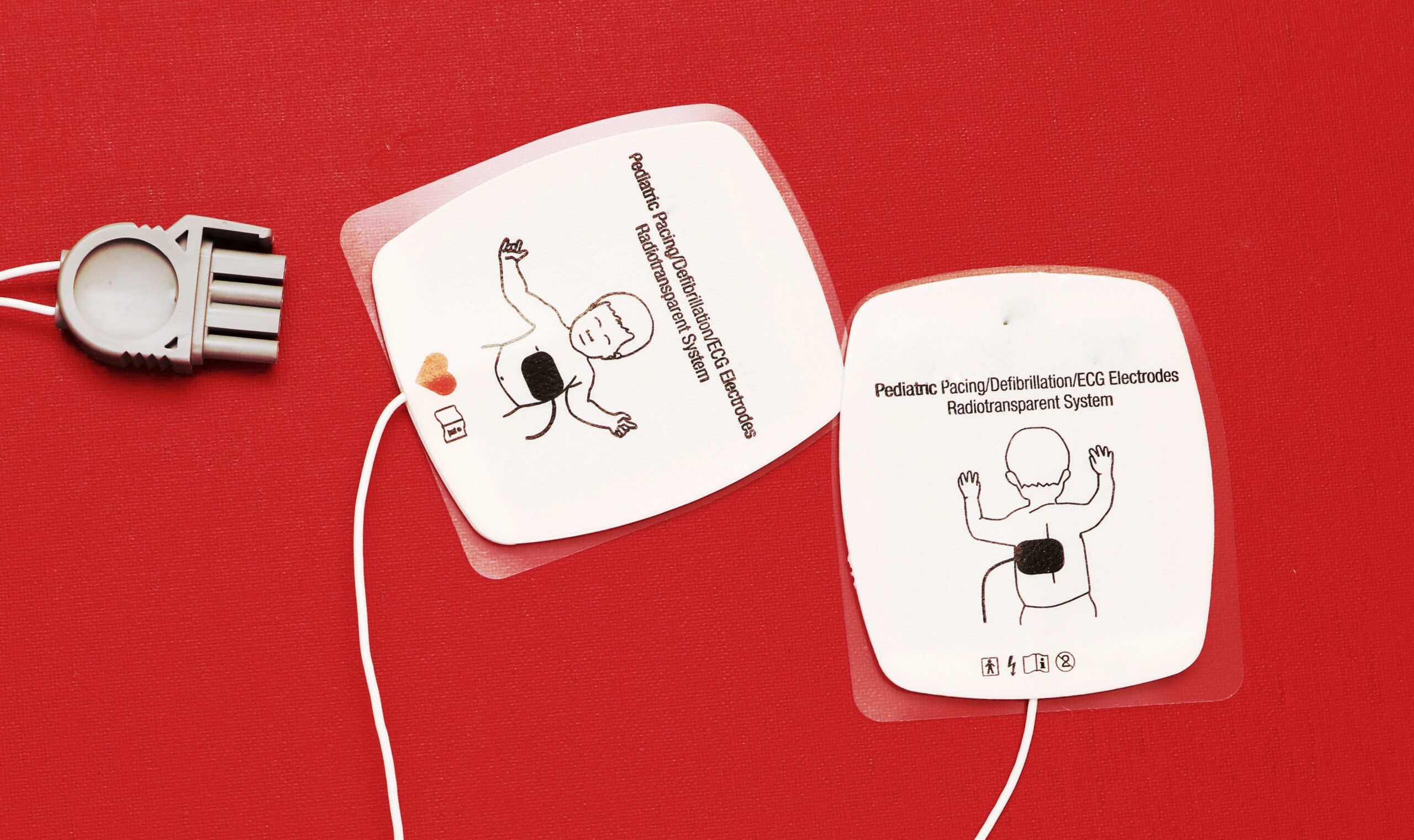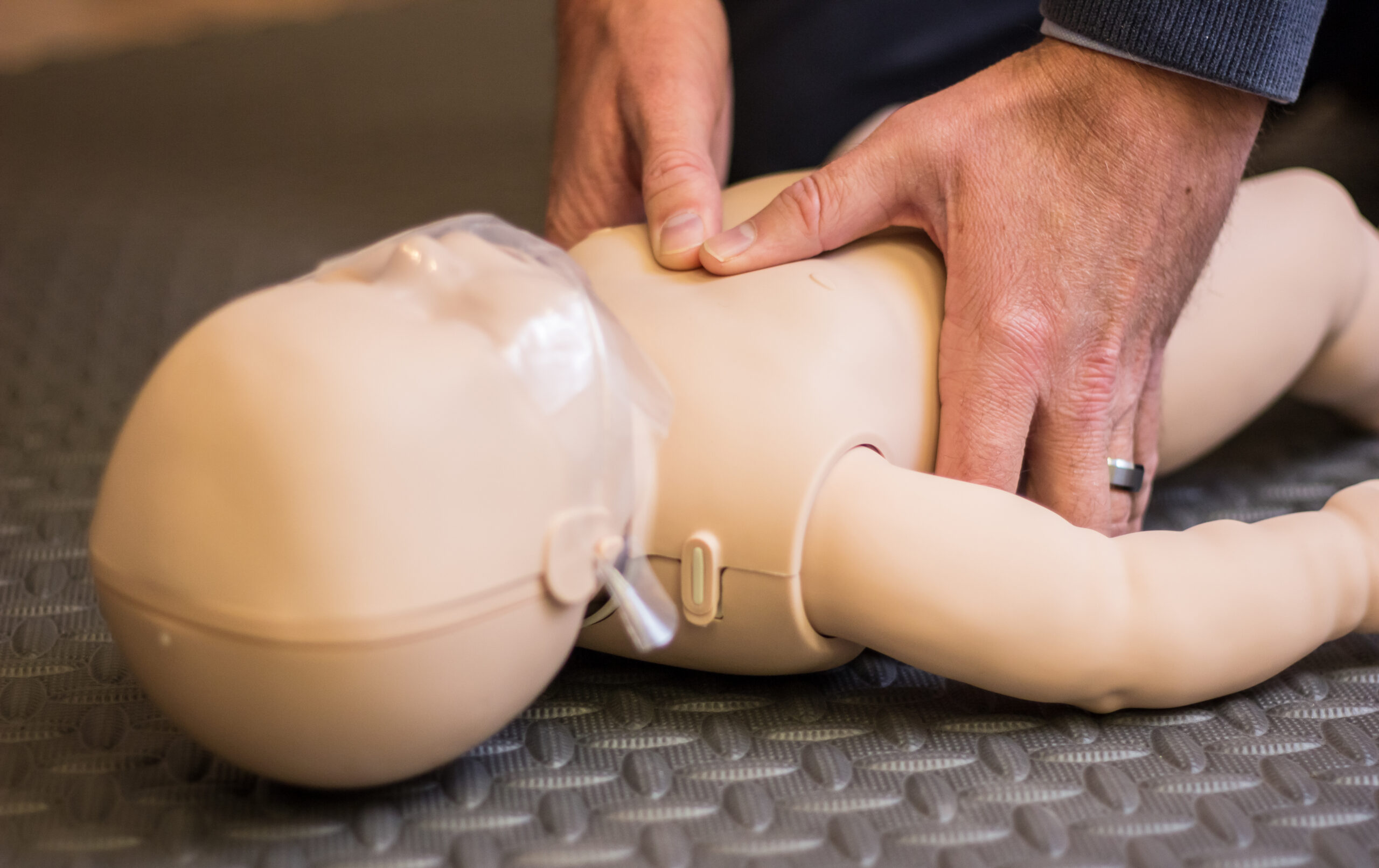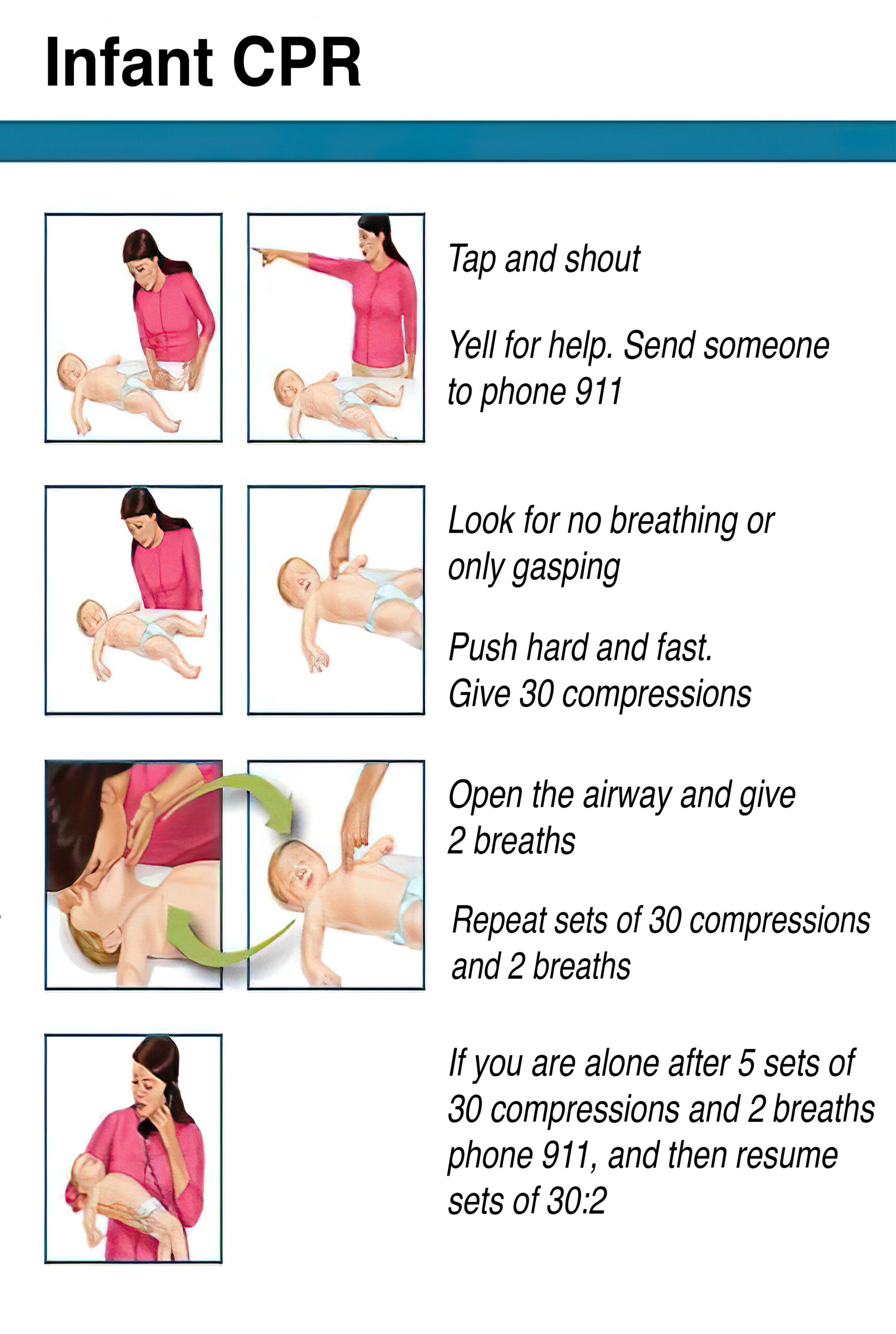CPR and AED Use for Infants
CPR Steps
Step 1: Verify Scene Safety
The lay rescuer must always ensure their own safety for a number of good reasons. One reason is to keep from adding another patient to the scene if a rescuer is in a dangerous situation. Another reason is that no one will rescue the patient if the lay rescuer is incapacitated.
If the patient needs to be moved away from danger, this becomes the lay rescuer’s priority.
Step 2: Determine Unresponsiveness, Then Call for Help
When a lay rescuer comes upon an unresponsive infant, the rescuer taps firmly on the infant’s foot while shouting, “Baby! Baby! Are you okay!?” to elicit a response such as movement or a cry.
When this action fails to elicit a response, the rescuer then calls for help with:
- Assistance in calling 9-1-1.
- Assistance in performing CPR.
- Seeing if someone else can get the AED.
If the rescuer is alone, they proceed straight to step 3 and assess for breathing. If CPR is necessary, after step 3, they immediately perform step 4, delivering CPR for five cycles before leaving the infant to call 9-1-1, ask for help, or get an AED (if the location is known).
Step 3: Assess for Breathing and Signs of Life
After calling for help, the lay rescuer assesses the infant for cardiac arrest. At this point, the lay rescuer is only concerned for the presence of breathing, no breathing, or only gasping. If the infant is not breathing or only gasping, the rescuer immediately proceeds to step 4: chest compressions.
If the infant is breathing, the rescuer remains to monitor them every 2 minutes while waiting for paramedics.
The lay rescuer has only 10 seconds to determine if the infant is in cardiac arrest.
Step 4: Initiate CPR
When it is determined that the infant is in cardiac arrest, rescuers should immediately perform high-quality CPR. High-quality CPR improves the patient’s odds of survival. If the technique is wrong, then the chances of survival diminish. Giving high-quality CPR is simplified by pushing hard and pushing fast on the center of the chest.
Single Rescuer Approach
Perform the two-finger technique. The single rescuer should use the two-finger approach to determining the placement of the hands for CPR. The instructions for rescuers are as follows:
- Locate the body of the sternum. It is a long and broad bone at the center of the chest.
- Using the index and middle fingers, apply pressure to the middle third of the sternum body and depress the center of the chest by about 1½ inches (or 1/3 the circumference of the infant’s chest) on the downstroke and allow full chest recoil in the upstroke. Full chest recoil means that there is enough space between the fingers and the chest that a piece of paper can be easily pulled out at the end of the upstroke.

Infant Two-Finger Compression Technique
- Give 100 to 120 chest compressions per minute. This can be timed to the tune of “Stayin’ Alive,” or the more recent popular kids’ song “Baby Shark.”
- After 30 chest compressions, open the airway and give two rescue breaths, also known as mouth-to-mouth resuscitation. To perform mouth-to-mouth resuscitation, rescuers:
- Perform the head tilt-chin lift maneuver.
- Form a seal between their mouth and the infant’s nose and mouth.
- Blow into the infant’s mouth and nose for 1 second, with enough pressure to elicit a visible chest rise.
Related Video: How to Perform CPR/BLS on an Infant
- Immediately resume CPR and repeat the cycle. The rescuer should only stop the process if the following has occurred:
- The AED gives a prompt to analyze the patient’s rhythm or recommends administering a shock.
- They are giving mouth-to-mouth breaths.
- There is a response from the infant.
- The paramedics have arrived to take over.
- Apply the AED once it is made available. Rescuers should use the pads made specifically for infants. If these are unavailable, adult pads can be used. If the pads are too big, one pad can be applied on the front and the other on the back.
- Defibrillate as soon as advised, even if it means pausing CPR. Immediately restart CPR after administering the shock.
- Stop CPR when the patient exhibits an improved level of consciousness or paramedics arrive to take over.
Related Video: Understanding Single Rescuer CPR for Infants

Pediatric AED Pad Placement
Two-Rescuer Approach
Perform the encircling-thumbs technique. The encircling-thumbs technique should be used for the two-rescuer approach. The instructions for rescuers are as follows:
- Locate the body of the sternum, a long and broad bone at the center of the chest.
- With two thumbs, apply pressure to the middle third of the sternum body and depress the center of the chest by about 1½ inches (or 1/3 of the circumference of the infant’s chest) on the downstroke, and allow full chest recoil in the upstroke.
- The second rescuer opens the infant’s airway and prepares to give mouth-to-mouth resuscitation.
- Give 100 to 120 chest compressions per minute. This action can be timed to the tune of “Stayin’ Alive,” or the more recent popular kids’ song “Baby Shark.”

Hands-Encircling Compression for Infants
- After 15 chest compressions, the second rescuer gives two rescue breaths, also known as mouth-to-mouth resuscitation. To perform mouth-to-mouth resuscitation, rescuers:
- Stop chest compressions.
- Perform the head tilt-chin lift maneuver.
- Form a seal with the mouth over the infant’s nose and mouth.
- Blow into the infant’s mouth and nose for 1 second, enough to elicit a visible chest rise.
- Immediately resume CPR and repeat the cycle. The rescuer should only stop the process if the following has occurred:
- The AED gives a prompt to analyze the patient’s rhythm or recommends administering a shock.
- The second rescuer is giving positive pressure ventilation.
- The rescuers switch roles.
- There is a response from the infant.
- The paramedics have arrived to take over.
- Apply the AED once it is made available. Rescuers should use the pads made specifically for infants. If these are unavailable, adult pads can be used. If the pads are too big, one pad can be applied on the front and the other on the back.
- Defibrillate as soon as advised, even if it means pausing CPR. Immediately restart CPR after administering the shock.
- Change roles after five cycles or roughly 2 minutes of high-quality CPR. The rescuers switch places. The goal is to prevent fatigue while giving chest compressions. Fatigue is a significant cause of poor CPR quality, and this starts even at the first minute of chest compressions.
- Stop CPR when the patient exhibits an improved level of consciousness or when paramedics arrive to take over.
Related Video: 2-Rescuer CPR for infants
How to Operate an AED for Infants
Early utilization of an AED has shown better outcomes in infants and children with witnessed cardiac arrest.
Related Video: Using an AED for an Infant
Each AED model is different. It is designed to provide the user with easy-to-follow instructions to operate. The following is a list of basic instructions for rescuers on using an AED:
- Switch on the device. Some AEDs automatically turn on once they are removed from the casing.
- Use the self-adhesive pads specially made for children with electrodes that are connected to a pediatric dose attenuator. The pediatric dose attenuator provides the amount of energy (35–50 J) recommended for children. If pediatric pads are not available, adult pads should be used.
- Apply the pad in the ANTERIOR-ANTERIOR position. If the infant is too small, the pad should be placed in the ANTERIOR-POSTERIOR position.
- Plug the electrodes into the AED.
- Do not touch the patient while the AED analyzes the rhythm.
- The AED will indicate if a shock is necessary.
- Perform chest compressions while the AED is charging.
- Once charged, stop compressions and clear the patient.
- When prompted to do so, push the SHOCK button.
- Resume CPR immediately after the shock is delivered.
- Check the pulse after 2 minutes or five cycles of CPR.
Inadvertently Shocking a Patient
If a patient already has an organized perfusing rhythm, and a shock was inadvertently delivered, that shock may cause a cardiac arrest rhythm (likely ventricular fibrillation).
When a shock is delivered across 100% oxygen (from a bag-mask device or oxygen insufflation therapy), it will ignite the oxygen gas. Therefore, when providing defibrillation, oxygen sources must be moved at least 1 meter from the patient before giving a shock.
Other rare and unwanted effects from an AED include precipitation of cardiac arrhythmia, myocardial injury, and skin burns.

Infant CPR Infographic